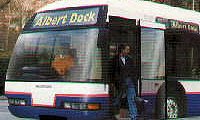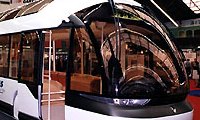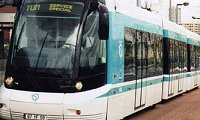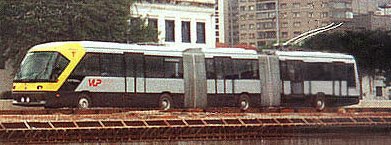




 |
 |
 |
 |
 | |||
 |
 |
 |
 |
| Cegelec AEG Promoted (unsuccessfully) for
Liverpool, the 'MRT' uses buried cables that guide the tbus by induction.
Conventional trolleybus overhead supplies the tractive
force. |
Renault/Matra
Civis Uses painted lines on the
roadway seen by a computer recognition system to steer the tbus.
Propulsion said to be by operator choice, although double overhead is more
realistic than a battery or diesel option. |
Ansaldo-Breda
Stream The most complex system, but
with the potential to replace inferred visually disruptive overhead. Uses
a magnetic pick-up to collect power, from a flexible conductor in a 300mm
x 600mmm trench. |
Bombardier GLT The most tram-like device, but
with rubber tyres. Utilising conventional rapid transit overhead but a
guiding and current returning buried mono rail, this tbus has also been
proposed with trolleybus overhead. |
| cost - high flexibilty - high capacity - medium status - project only http://www.atco.org.uk/news/ news983/mtravel.htm |
cost - medium flexibilty - high capacity - high status - prototype building http://www.matra-transport.fr/gb/civis/index.html |
cost - high flexibilty - medium capacity - medium status - Treiste trial http://www.ansaldo stream.com/English/technol.htm |
cost - low flexibilty - low capacity - high status - trial built http://transport.bombardier.com/htmen/pr_2_23.htm |
Marcopolo/Volvo/Powertronics The Volvo B10M chassis with a
Marcopolo body is being used in the "Fura-Fila" (Queue Jumper) guided
trolleybus system that is now in the prototype stage and expected to enter
revenue service on a suburban bus corridor in Sao Paulo later this year.
Marcopolo, Volvo, and Powertronics of Brazil developed the prototype,
which has been tested on its own track for the past year. The full system
is expected to be completed by 2002 with a total of 450 vehicles, each of
which is eighty-two feet long and will have a capacity of 270 passengers.
While Brazil’s current economic problems may make this projection overly
optimistic, the prototype LVT has operated successfully on a test track
since early last year. The test track is configured with various curves
and grades, and the prototype clocked up some 7,000 road kilometers under
simulated fully and partially loaded conditions. The private operator, Sao
Paulo Transporte S.A., plans for its first 8.5-km, partially elevated
route—between Dom Pedro Park in downtown Sao Paulo and the Sacoma district
to the southeast—to enter full operation this year with a total of 31
vehicles. Thirteen more vehicles will be added in the second phase, when
the extended route will be served by 11 platform stations. The complete
system will include extensions of the initial route, several other
commuter routes from the downtown area, and a circular connecting link.
According to the figures obtained from company executives, construction
costs of the bi-articulated trolleybus system are significantly lower than
those of other alternatives in one of the world’s largest cities, which
now has a metropolitan area population of 17 million and is growing
rapidly. Building costs have been estimated at £9.5 million per kilometer,
or £15 million per mile. A similar system using light rail would run the
equivalent of £25 million per kilometer (£40 million per mile), while
subway extensions in Sao Paulo were estimated by local officials to cost
upwards of £63 million/km (£100 million/ mile). Other reasons favoring the
non-polluting LVT include environmental concerns, domestic manufacture,
and the current operation of a mostly over-age trolleybus fleet totaling
nearly 500 vehicles. |
Going Green the trolleybus
way Propelling a vehicle by
electricity from a large fixed power plant is MUCH more environmentally
friendly than by an on board diesel or natural gas engine, or a fossil
fuel powered fuel cell or whatever. Fossil fuels can be burned in modern
power stations perhaps TWICE as efficiently as on board a vehicle. Thus
only about HALF the amount of fossil fuel has to be burned and about HALF
the amount of the green house gas pollutant Carbon Dioxide [CO2] is
produced. Other pollutants such as sulphur and nitrogen oxides, Carbon
Monoxide [CO], and particulates [smoke] from power stations are minute
compared with vehicle engines. In addition of course, they are not
discharged straight in the street for people to breath! If the power
station is not fossil fuelled but solar, wind, wave, water, biomass, etc.,
fuelled, then the central generation of power is incomparably
environmentally better than burning fossil fuels on vehicles. In the case of rail applications, where the additional infrastructure required for the distribution of electric power tends to be a small proportion of other costs, electric propulsion is usually the norm nowadays. For urban bus routes, and looking at whole life costs, the infrastructure required for electric propulsion can be funded from reduced operating costs. In other words, trolleybuses offer very significant environmental advantages over diesel, natural gas, hydrocarbon fuel cell, etc, buses, but without incurring a cost penalty. Fuel cells fuelled by hydrogen produced off-board by renewable sources may provide an ultimate 'green' transport, but the technology and the infrastructure have yet to be fully developed. The environmental case for the trolleybus is that not only is it a TRUE zero emission vehicle, it produces much less greenhouse gas [CO2] as well as very much less in the way of other ['minor'] pollutants like nitrogen or sulphur oxides. The trolleybus is also very quiet. The issue of fuel cell versus trolley vehicles is really a red herring - the best way in the future to use fuel cells will probably to put big fuel cells in power stations, rather than small ones on vehicles, where the distribution infrastructure costs can be recouped from operating savings with electric vehicles i.e urban [trolley]bus routes. Irvine Bell |